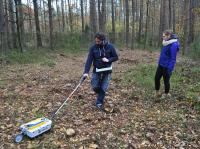Surveyors from WUT in Search for the Secrets of Treblinka
When the Nazis left the extermination camp in Treblinka, they made every effort so that no one would find out what had happened there. They razed the camp buildings and planted lupine. Today, our knowledge about the events in Treblinka is increasingly richer, thanks to, among others, scientists from the Warsaw University of Technology.
The team, led by Sebastian Różycki, PhD (Eng.) from the Faculty of Geodesy and Cartography of the Warsaw University of Technology, decided to take advantage of archival and current spatial data to study the labour camp in Treblinka.
“A few years ago, I noticed that no one in Poland uses aerial photos made during WWII”, says Sebastian Różycki, PhD (Eng.). “So, I decided to use these sources in my work”.
In his scientific career, Dr Różycki first searched for unexploded ordnances and duds using aerial photos. About five years ago, he began using this method to search for mass graves. The Rabbinical Commission for Cemeteries took interest in his ideas. Since Jewish law prohibits disturbing burial sites, archaeological studies at extermination camps or Jewish cemeteries are practically impossible. Using Spatial Information Systems, archival aerial photos and non-destructive examinations turned out to be a great solution for this purpose.
Collaboration with the Museum in Treblinka began approximately 4 years ago, when Dr Różycki and historian Marek Michalski presented their ideas to Edward Kopówka, PhD, the Museum director. “Even though we believed that archaeologists and other scientists have thoroughly examined this topic during the past 70 years since the end of WWII, it turned out that there is still much to discover in Treblinka”, explains Dr Różycki. “There was no confirmed information e.g. concerning the area of the labour camp”.
Secrets of the Camp
There were two camps in Treblinka: the labour camp (Treblinka I) and the extermination camp (Treblinka II), situated 2 km from each other. The labour camp was built in 1941 as a direct result of Germany’s invasion of the Soviet Union. In July 1942, Jews from ghettos in Warsaw and Radom were brought to Treblinka. About 850 thousand people died in Treblinka. Among extermination camps operating in the occupied Europe during WWII, more people died only in Auschwitz-Birkenau.
After the war, in 1946, Polish investigators studying Treblinka discovered underground basements, parts of barbed wire and other evidence for the existence of the camp’s administrative buildings.
In August 2012, non-destructive archaeological techniques were applied to study the former extermination and labour camp. Archaeological excavation works took place a year later. The studies and works were led by Dr Caroline Sturdy Colls, a forensic archaeologist from Staffordshire University.
However, some of the secrets of Treblinka still remain undiscovered.
Maps, Photos, Witness Statements
The project of the WUT scientists took advantage of Spatial Information Systems (SIS), which enabled them to connect witness statements and memories with available and newly gathered spatial data. “Even though witness statements were examined quite well already, we wanted to look at them from a different perspective”, explains Dr Różycki. “We looked for spatial information in these sources. The most important statements specify e.g. how long, how far, and via which route did the prisoners walk to the edge of the forest, where they were shot. This helps us to create so-called relation maps containing walk routes and placements of buildings or gates”.
Furthermore, in order to obtain the full picture of the operation of the Treblinka camp, the researchers used aerial photos from 1940–1956, pre-war topographic maps, laser scanning data, results of georadar and gravimetric measurements, and current satellite images.
“The most important source are aerial photos, of which there obviously aren’t many”, says the project leader. “In this case, we had photos of the labour camp from 1944 (when it was still operational), and photos of the extermination camp made shortly after its decommissioning. Let’s keep in mind that these photos are in black and white and completely illegible to the layman.
Archival aerial photos are processed to the metric form. Specific places can be placed in the coordinate system and checked exactly where they were, and then their position in the field can be determined using modern GPS technologies.
To Preserve the Memory
After integrating this information and preparing appropriate plans, the scientists selected 4 places where mass graves were possible. First, non-destructive, gravimetric and georadar studies were conducted. Then archaeological works began at the selected spot, where the existence of mass graves was suspected. Their results confirmed the researchers’ speculations. This made it possible to secure and commemorate these places.
Moreover, unknown remnants of the camp’s topography have been located. Based on aerial photos, the scientists have found a railway siding at the gravel pit, which was very close to the labour camp. Archaeological studies confirmed that railway ran through there. The researches have also managed to examine the former separation facilities, where garments and equipment of soldiers from the front lines were brought.
Tackling the topic of extermination is surely difficult. Sebastian Różycki, PhD (Eng.) collaborates with historians who help him analyse witness statements. Still, you cannot escape from drastic description and photos. “I know from experience of other people, if you stray too deep into this topic, you sometimes have to take a break, even as long as a few years”, says the researcher. “Therefore, the work at the university and the didactic method allow us to keep our distance”.
Interestingly, Dr Różycki teaches new generations of young engineers who prepared their theses on similar subjects.
Research at the Treblinka camp was conducted on behalf of the Ministry of Culture and National Heritage. Dr Różycki is also committed to similar research conducted in other camps in Sobibór and Kraków-Płaszów. “Thanks to our works, maybe we’ll be able to organise the knowledge of labour camps and properly commemorate these places”, says Dr Różycki.
Monika Bukowska
Office for Promotion and Information










